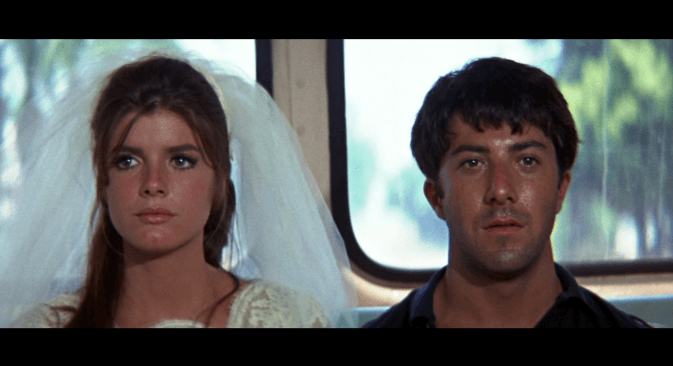The Graduate Analysis: Audiences and Film Criticism
Film reviews are, more than anything, a reflection of their audience. Where most films aim to entertain their respective audiences, film reviews aim to inform their readers. Both mediums call for the author or director to anticipate what the audiences’ want, while also providing an individual style. Since the audience plays such an integral role in film reviews, it stands to reason that different audiences will influence reviews in different ways. In this essay, I will look at the public analysis of The Graduate in comparison to critical reviews.
The two primary distinctions can be seen in “mass-market” and “highbrow” sources. Mass-market film reviews come from sources that reach a much larger audience and attempt to appeal to the “average” tastes of the public, while highbrow reviews are aimed at smaller niche groups, who often have, or at least purport to have, more refined tastes. The similarities and differences between these two groups are particularly evident in the reviews for The Graduate (1967), a film directed by Mike Nichols.
The Graduate tells the story of a bemused college graduate named Ben who, upon returning home from school, finds himself thrust into an affair with a much older woman. As the story progresses, Ben (played by Dustin Hoffman) falls for a girl closer to his own age, only to discover that she is the daughter of his seductress, Mrs. Robinson. While some aspects of the reviews are very similar, there are several glaring differences between the reviews of the mass-market and highbrow sources. Due in large part to the difference in readership expectations, mass-market reviewers evaluate The Graduate through individual performances and overall plot, while highbrow reviewers focus on Nichol’s quality as an auteur and the broader social context of the film.
While film reviewers from both groups do not focus exclusively on actors or directors, mass-market reviewers put more emphasis on acting performances, while highbrow reviewers emphasize directing strategies. Mass-market sources have a readership that, in general, are not attracted to films for the director alone, nor do they try to analyze the film as a reflection of the director. Rather, they are drawn to certain films based on story and star power, which is reflected in the mass-market reviews. For example, Sun-Times reviewer Roger Ebert summarizes the entire plot in his review, even to the point of revealing the ending (Ebert). Along with summarizing the plot, Ebert evaluates each of the main characters’ performances for the reader. He states that Dustin Hoffman is “so painfully awkward and ethical that we are forced to admit we would act pretty much as he does” (Ebert).
He continues to say that Anne Bancroft’s portrayal of Mrs. Robinson is “sexy, shrewish, and self-possessed enough to make the seduction convincing” (Ebert). The Sun-Times review gives its readers an extensive summary of the entire plot and detailed descriptions of the characters and actor performances. The Time Magazine review evaluates the film in a similar fashion. The plot is again described in its entirety, revealing how “Benjamin revs up his psyche…and heads to Santa Barbara to break up the wedding” (Fuerbringer). The performances are also analyzed, with Hoffman described as an “original, likable actor” and Anne Bancroft as “sly and predatory” (Fuerbringer). Since mass-market readers primarily go to films based on their interest in the plot and appreciation for certain actors and actresses, the reviews primarily appeal to these aspects of The Graduate.

Highbrow reviews do evaluate performances, but they also put heavier emphasis on auteurship and certain aesthetic qualities that are not attributed to the actors. Whether praising the film or criticizing its weaknesses, highbrow reviewers appeal to readers who expect a more in-depth analysis of the creative practice that takes place outside of the frame. In the National Review article “Film Chronicle,” Richard Corliss focuses heavily on Nichols’ directing style. He states that in The Graduate, Nichols is “forcing his story upon us with a muscular cinematic tone” (Corliss 459). He also describes Nichols’ work as a “gratuitous homage” to many other directors, including “Francois Truffaut, Agnes Varda, and Orson Welles” (Corliss 460).
» You Might Like: Gender and Sexuality in Breillat’s Fat Girl
Unlike the reviewers from mass-market sources, Corliss writes for an audience that is more likely to have seen the works of Welles or Truffaut, and more likely to appreciate the director as the source of the film’s artistry. His review also puts emphasis on the visual style and form of The Graduate by comparing certain elements of the film to Citizen Kane. He references the use of “deep-focus to clarify and isolate the characters…long takes and little camera movement, [and] mastery of blocking actors and directing dialogue” (Corliss 460). Rather than focusing on visual style, Esquire writer Alfred Sheed criticizes Nichols as a storyteller. He states that The Graduate “is a cartoon, not a real story, and a cartoon demands a certain tightness and consistency of intention” (Sheed 39). Sheed attributes the film’s “cartoonish” qualities to Nichols’ directing and blames him for the “lackluster variations on the original theme” (Sheed 38). The prominence of visual style and auteurship in these highbrow reviews is a reflection of the refined, or at least more discriminating, tastes of their readerships.
Along with the concept of auteurship, highbrow reviewers stress the importance of the underlying social context in The Graduate. While the film makes few direct references to historical events of the time, it serves as an observation of the American youth in the 1960’s and the relationship between younger and older generations. Wilfred Sheed recognizes Ben as a singular youth being pulled in different directions by his parents’ generation. When Ben returns from college, “corruption is offered to him” and subsequently a “woman seduces him” (Sheed 38). Despite its place in popular culture and the social setting of 1960’s America, Sheed criticizes the main topic of the film by simply stating that “American youth is a frigging bore” (Sheed 39).
While Sheed does not find American youth to be an interesting topic, he does stress the importance of 60’s youth culture in the plot. Richard Corliss also addresses the social setting of the film, but views it in a much more positive light. While Corliss does recognize the themes concerning generational differences, he focuses more heavily on the aspects of the film that are uniquely American. For example, Corliss references the generational gaps by summarizing one of Ben’s problems: “[He] never trusts anyone over thirty” (Corliss 460). However, the review puts more emphasis on the national unity within the film. The Graduate is described as “the most American movie of 1967, because its strengths and weaknesses are ours. It shows us the United States of the Sixties in the fond, exaggerated way the screwball comedies of the Thirties revealed their own era” (Corliss 1960). The Highbrow reviewers evaluate the film as both a reflection of social settings in America in the 1960’s, and an observation of American youth.
While the disparities between mass-market and highbrow reviews are much more glaring than their similarities, they do share a few similar views of The Graduate. The most obvious similarity is the inconsistency within each group to either praise or pan the film. As one of the highbrow reviewers, Wilfred Sheed describes the film as “cute and trivial” and criticizes Dustin Hoffman for “consciously holding back too much” (Sheed 39). Similarly, the Time Magazine review criticizes the screenplay for being “alarmingly derivative” (Fuerbringer). Alternatively, the Sun-Times review praises The Graduate for being “the funniest comedy of the year” (Ebert). Also in a similar fashion, The New York Times praises the film for being “funny, outrageous, and touching” (Crowther).
The other important similarity between the mass-market and highbrow reviews is the recognition of a vast shift in tone during the film. Harper’s Magazine reviewer Robert Kotlowitz denounces the film, believing that Nichols and his screenwriters “open The Graduate with a real hero living in a real world and conclude with a parody-hero living in a parody-world” (Kotlowitz 156). The Time Magazine review notes that the film “which begins as genuine comedy, soon degenerates into spurious melodrama” (Fuerbringer). Regarding this shift as a hybrid of narrative and technical form, the Esquire review states that “in line with a growing Hollywood tradition, it puts the ideas in one part and the pretty photography in the other” (Sheed 38).
Though the reviews for The Graduate are similar in certain observations, they focus on very different concepts when analyzing the film. The “mass-market” reviews focus on the interests of their readers: star power and plot summary. The masses want to know what films are good and which stars perform well. The “highbrow” reviews also focus on the interests of their readers: auteurship and social context. Highbrow readers want to know which films best exemplify the artistic talent of the director and also stay relevant to the times. This collection of vastly different media sources provides diverse perspectives on The Graduate to appeal to their respective audiences’ expectations.
Corliss, Richard. “Film Chronicle.” Review of The Graduate. National Review. 7 May 1968: 459-60. Print.
Crowther, Bosley. “Movie Review – The Graduate.” Review of The Graduate. The New York Times. 22 December 1967. Web. 20 September 2011. <http://movies.nytimes.com/movie>.
Ebert, Roger. “The Graduate.” Review of The Graduate. Chicago-Sun Times. 26 December 1967. Web. 20 September 2011. <http://rogerebert.suntimes.com>.
Fuerbringer, Otto. “Cinema: The Graduate.” Review of The Graduate. Time Magazine. 29 December 1967. Web. 20 September 2011. <http://www.time.com/time/magazine>.
Kotlowitz, Robert. “Capote’s Killers, And Others.” Review of The Graduate. Harper’s Magazine. March 1968: 155-56. Print.
Sheed, Wilfred. “Films.” Review of The Graduate. Esquire. April 1968: 38-39. Print.
For more essays like this one, check out the Philosophy in Film Homepage!

